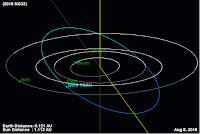Asteroid (281375) 2008 JV19 passed by the Earth at a distance of 17 640 000 km
(45.9 times the average distance between the Earth and the Moon, or 11.8% of
the average distance between the Earth and the Sun), slightly after 7.20 am
GMT on Tuesday 30 August 2016. There was no danger of
the asteroid hitting us, though had it done so it would have presented a
considerable threat. (281375) 2008 JV19
has an estimated equivalent
diameter of 130-410 m (i.e. a spherical body with the same mass would be 130-410 m in diameter), and an asteroid of this size
would be expected to pass through the atmosphere and directly impact the ground with a
force of 32-176 000 megatons (1900-2350 times the
explosive energy of
the Hiroshima bomb), causing devastation over a wide area and creating a
crater roughly 2-7 km across, and resulting in global climatic problems
that
could last for decades or even centuries.
The calculated orbit of (281375) 2008 JV19. JPL Small Body Database.
(281375) 2008 JV19 was discovered on 8 May 2008 by the University of Arizona's Catalina Sky Survey,
which is located in the Catalina Mountains north of Tucson. The
designation 2008 JV19 implies that it was the 496th asteroid (asteroid V19)
discovered in the first half of May 2008 (period 2008 J), while
the designation 281375 implies that it was 281 375th asteroid ever
discovered (asteroids are not given this longer designation immediately
to avoid naming double or false sightings).
(281375) 2008 JV19 has a 358 day orbital period, with an elliptical orbit tilted at
an angle of 7.23° to the plain of the Solar System which takes in to
0.74 AU from the Sun (74% of the distance at which the Earth orbits the
Sun and slightly outside the orbit of the planet Venus) and out to
1.23 AU (23%
further away from the Sun than the Earth). This means that close
encounters between the asteroid and Earth are fairly common, with the
last thought to have happened in September 2015 and the next predicted
in August 2017. (281375) 2008 JV19 also has frequent close encounters with the
planet Venus, with the last thought to have occurred in March 2004
and
the next predicted for September 2025. Although it does cross the Earth's
orbit and is briefly
further from the Sun on each cycle, (281375) 2008 JV19 spends most of its time
closer to the Sun than we are, and is therefore classified as an Aten
Group Asteroid. As
an asteroid possibly larger than 150 m in diameter that occasionally
comes within 0.05 AU of the Earth, (281375) 2008 JV19 is also classified
as a Potentially Hazardous Asteroid.
See also...
 Asteroid 2016 QA2 passes the Earth. Asteroid
2016 QA2 passed by the Earth at a distance of 86 570 km (0.23 times
the average distance between the Earth and the Moon, 0.06% of...
Asteroid 2016 QA2 passes the Earth. Asteroid
2016 QA2 passed by the Earth at a distance of 86 570 km (0.23 times
the average distance between the Earth and the Moon, 0.06% of... Asteroid 2016 CL264 passes the Earth. Asteroid 2016 CL264 passed by the Earth at a distance of 8 723 000 km
(22.7 times the average distance between the Earth and the Moon, or 5.83% of
the average distance between the Earth and the Sun), slightly after 6.05 pm
GMT on Monday 8 August...
Asteroid 2016 CL264 passes the Earth. Asteroid 2016 CL264 passed by the Earth at a distance of 8 723 000 km
(22.7 times the average distance between the Earth and the Moon, or 5.83% of
the average distance between the Earth and the Sun), slightly after 6.05 pm
GMT on Monday 8 August... Asteroid 2016 NG33 passes the Earth. 2016
NG33 passed by the Earth at a distance of 18 070 000 km
(47 times the average distance between the Earth and the Moon, or 12% of
the average distance between the Earth and the Sun), at about 2.50 am
GMT on Monday 8 August 2016. There...
Asteroid 2016 NG33 passes the Earth. 2016
NG33 passed by the Earth at a distance of 18 070 000 km
(47 times the average distance between the Earth and the Moon, or 12% of
the average distance between the Earth and the Sun), at about 2.50 am
GMT on Monday 8 August 2016. There...
Follow Sciency Thoughts on Facebook.

